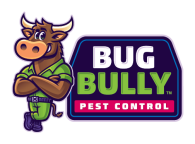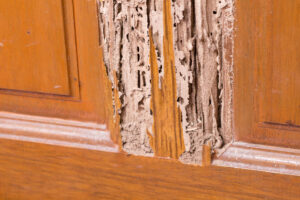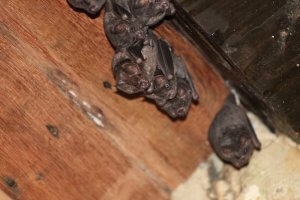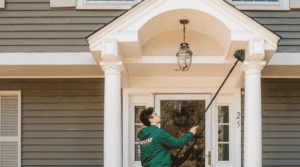At Bug Bully Rodent & Pest Control, we often receive calls from homeowners, apartment renters, and restaurant owners in Central Massachusetts who are surprised to discover bats inside their properties. While bats are important to the environment, providing natural insect control and maintaining balance in ecosystems, they are not welcome houseguests. Knowing where bats hide in homes is the first step in understanding why they choose certain spaces and how professional bat removal can solve the problem.
In communities like Worcester, Framingham, Northborough, and Concord, older buildings and historic homes provide plenty of opportunities for bats to find small openings and create roosting spots. Once inside, bats may remain hidden for long periods, making it difficult for property owners to detect them until droppings or strange noises appear. By learning more about their behavior and preferences, you can better understand how to identify and address an infestation before it grows into something more problematic.
Why Bats Enter Homes and Businesses
Bats are constantly searching for warm, safe, and undisturbed places to rest during the day. In Central Massachusetts, they are particularly attracted to man-made structures that provide shelter from predators and harsh weather. Houses, apartment complexes, and restaurants can all offer exactly what bats are looking for: narrow gaps, attic spaces, and sheltered cavities that mimic natural caves or hollow trees.
The most common reason bats enter homes and businesses is to establish a roost where they can rest, reproduce, and raise their young. Female bats often seek quiet, warm areas in the summer to form maternity colonies. Restaurant buildings, especially older ones with basements or lofts, can also provide ideal conditions for bats to settle. Once they discover an opening, bats will return regularly because they are creatures of habit.
Common Places Bats Hide in Homes
Bats are experts at finding the smallest entry points and squeezing into spaces you might not notice. In Worcester and other nearby cities, many homes have architectural designs that unintentionally create bat-friendly conditions. Some of the most common hiding places include attics, chimneys, rooflines, and wall voids.
Attics are perhaps the most frequent location for bats in Central Massachusetts homes. The warmth and darkness provide an ideal roosting environment, and bats can go unnoticed for months if homeowners rarely visit the attic. Chimneys also attract bats because they resemble natural caves, and unless they are properly capped, they provide easy access. Rooflines, especially where soffits or flashing are worn, allow bats to slip through small cracks. Inside wall voids, bats can roost quietly while remaining hidden from view, although scratching sounds or droppings may reveal their presence.
For restaurant owners, bats may hide in storage areas, basements, or unused sections of a building. These locations are often dark and quiet, making them appealing to bats seeking shelter. Because of health regulations, even a single bat in a restaurant can create serious compliance concerns, making bat removal a top priority.
Signs That Bats May Be Hiding Inside
Identifying a bat problem can be challenging, but there are several key signs to look for. One of the most common is the appearance of guano, or bat droppings, which often accumulate near entry points or beneath roosting sites. Unlike rodent droppings, guano tends to break apart easily and may contain shiny insect parts. The smell of guano can also be strong and unpleasant, particularly in confined areas.
Another sign is unusual noises. Homeowners may hear scratching, squeaking, or fluttering sounds coming from attics or walls, particularly at dusk or dawn when bats are most active. In some cases, bats may even be seen flying inside the home after accidentally entering through a chimney or open window. For restaurants, employees may notice bats emerging from the building at night, which can be alarming for staff and customers alike.
Health Risks Associated with Bats
While bats are beneficial to the environment, their presence in homes and businesses poses several risks. The primary concern is the accumulation of guano, which can harbor a fungus that may cause histoplasmosis, a respiratory illness. The pungent odor of droppings can also permeate walls and ceilings, creating an unhealthy environment.
Another risk involves the small possibility of rabies transmission. Although most bats do not carry rabies, it is a serious disease, and any direct contact should be taken seriously. For restaurant owners, the presence of bats can threaten both public health and the reputation of the establishment. These risks highlight the importance of professional bat removal rather than attempting to handle the issue independently.
Why Bats Prefer Central Massachusetts Properties
The architecture and age of many homes and businesses in Central Massachusetts contribute to frequent bat issues. Worcester and Framingham are known for their mix of historic and modern buildings, and older structures often have gaps around rooflines, chimneys, and siding. In Northborough and Concord, properties surrounded by wooded areas provide easy access for bats to move between natural habitats and man-made shelters.
The climate in Massachusetts also plays a role. As temperatures drop in the fall, bats look for secure hibernation sites. Buildings with stable temperatures and limited disturbances become attractive options. This combination of environmental and structural factors explains why bats are commonly found hiding inside homes and businesses throughout the region.
Common Questions About Bats in Homes
One of the most frequent questions we hear at Bug Bully is, “How do bats get inside in the first place?” The answer often surprises property owners. Bats can fit through openings as small as half an inch, which means tiny cracks around windows, vents, or roof edges can serve as entry points.
Another common question is, “Will bats leave on their own?” While bats may occasionally relocate, they often return to the same roost year after year. Without proper exclusion, the problem will likely persist.
Homeowners and restaurant owners also ask, “Can I remove bats myself?” It may be tempting to try, but do-it-yourself methods are rarely effective and can be dangerous. Bats are protected species in Massachusetts, and removal must be done carefully and legally. Attempting removal without professional guidance can result in harm to both the bats and the property owners.
Finally, many people want to know, “What happens during professional bat removal?” At Bug Bully, our process involves a thorough inspection to locate entry points and roosting sites. We then use exclusion devices that allow bats to exit safely but prevent them from returning. Once the bats are gone, we seal entry points to ensure long-term protection.
Why Professional Bat Removal is Essential
Trying to solve a bat problem without expert help is not only ineffective but can also be hazardous. Professional bat removal ensures that the process is safe, humane, and compliant with Massachusetts regulations. At Bug Bully, we use proven exclusion techniques that allow bats to leave without harm. We also focus on prevention by sealing entry points and providing guidance on keeping properties secure in the future.
For homeowners, this means peace of mind knowing that your family is safe from potential health risks. For restaurant owners, it ensures compliance with health codes and protects your reputation with customers. Our team has more than a decade of experience serving Central Massachusetts, and we understand the unique challenges that properties in Worcester, Framingham, Northborough, and Concord face.
Preventing Bats From Returning
Once bats have been removed, prevention becomes the next step. Regular inspections of rooflines, chimneys, and siding are essential to identify potential entry points. Installing chimney caps and repairing loose shingles can make a significant difference. In some cases, reducing outdoor lighting can also help, as it attracts insects that bats feed on, drawing them closer to the building.
At Bug Bully, we provide exclusion services that focus on long-term results. By sealing gaps and ensuring that potential entry points are addressed, we help property owners avoid future infestations. This proactive approach saves time, stress, and money while maintaining a safe and healthy environment.
Why Choose Bug Bully Rodent & Pest Control
As a locally trusted company, Bug Bully Rodent & Pest Control has spent years helping Central Massachusetts residents and business owners with bat removal and prevention. Our team is fully licensed, and we prioritize safety by using environmentally responsible methods. We understand that dealing with bats can be unsettling, and our goal is to make the process as straightforward as possible.
We also provide emergency services, knowing that bats inside a restaurant or home require immediate attention. Scheduling with us is simple, and we stand behind our work with guaranteed results. Whether you own a historic home in Concord, manage an apartment complex in Framingham, or run a restaurant in Worcester, Bug Bully has the experience and dedication to solve your bat concerns.
Conclusion
Bats are fascinating creatures, but their place is in the wild, not in your home or business. Knowing where bats hide in homes helps property owners in Central Massachusetts understand the risks and recognize the importance of professional bat removal. From attics and chimneys to wall voids and basements, bats can adapt to a variety of hiding spots, making them difficult to detect and control without expert help.
At Bug Bully Rodent & Pest Control, we are committed to providing safe, humane, and effective solutions to keep your property free from bats. Serving Worcester, Framingham, Northborough, and Concord, we combine local knowledge with professional expertise to deliver results that last. If you suspect bats are hiding in your home or business, give us a call for a free estimate and let us help you reclaim your space with confidence.











